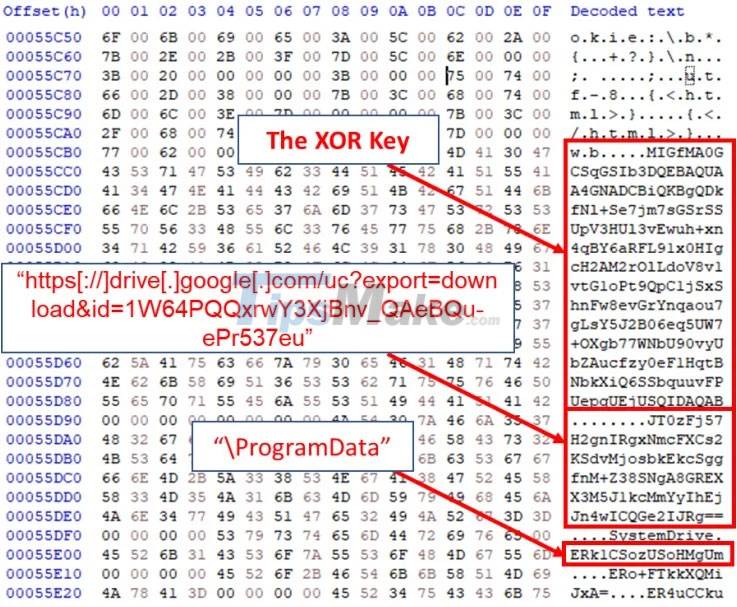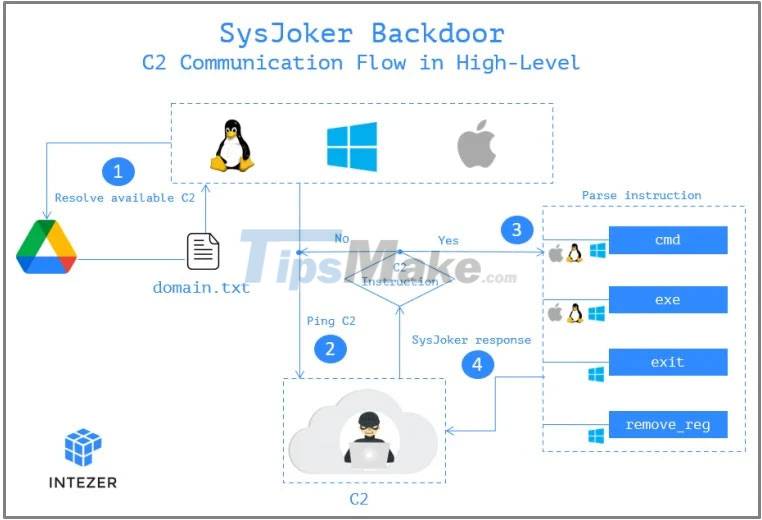Detecting dangerous backdoors targeting both Windows, macOS and Linux
This backdoor-type malware is currently actively targeting Windows, Linux and macOS - the world's three most popular PC operating system platforms - with extremely sophisticated evasion of detection.
If you do not know, a backdoor is a tool (program or program-related) used by a hacker to install on a system to bypass the security barrier of a device or software remotely. Because the computer's security system cannot see the backdoor, the victim may not realize that their computer has this dangerous vulnerability. In other words, users will not know the existence of a backdoor on their system until it is detected.
Detecting backdoors in devices is generally extremely difficult. This new malware was discovered and named by researchers at Intezer, who first saw signs of its activity in December 2021, after investigating an attack on a server fairly large-scale Linux-based web.
Similar to other types of backdoors, SysJoker's fear lies in the fact that it is very good at evading detection, allowing it to cause long-lasting, insidious damage without the victim realizing it.
A 'Joker' who doesn't like attracting attention
This malware is written in C++. In particular, it will have many different variants, each of which is tweaked to suit each operating system it targets. It is worth mentioning that all of them went undetected on VirusTotal, a popular online malware scanning website that uses 57 different antivirus engines.
On Windows, SysJoker uses PowerShell commands to perform the following malicious tasks:
- Fetch the SysJoker ZIP from the GitHub repository.
- Extract it on "C:/ProgramData/RecoverySystem/".
- Deploy payload.
The malware then 'sleeps' for up to 2 minutes before creating a new folder and replicating itself as Intel Graphics Common User Interface Service ('igfxCUIService.exe').

Next, SysJoker will gather information about the machine using a sequence of Living off the Land (LOtL) commands. SysJoker uses various temporary text files to record the results of commands. These text files are then deleted immediately, stored in a JSON object, then encoded and written to a file named "microsoft_Windows.dll'.
After collecting system and network data, the malware improves its stability by adding a new registry key:
HKEY_CURRENT_USER/Software/Microsoft/Windows/CurrentVersion/Run
The next step for the malware is to gain access to the hacker-controlled C2 server using a hard-coded Google Drive link.

The association hosts the "domain.txt" file, which the agent regularly updates to make available servers for live signaling. This list is constantly changing to avoid detection and blocking.
System information collected during the first stage of infection is sent as the first handshake to C2. C2 responds with a unique token that serves as the identifier of the infected endpoint.
From there, C2 can command the backdoor to install more malware, run commands on the infected device, or even command the backdoor to remove itself from the device.

The same procedure is also found on Linux and macOS variants.
Detect and prevent
Intezer provided the full range of Intrusion Indicators (IOCs) in its report. Thereby administrators can use it to detect the presence of SysJoker on their systems.
Here are some IOCs for each operating system:
On Windows, the malware files are located in the folder:
C:/ProgramData/RecoverySystem at C:/ProgramData/SystemData/igfxCUIService.exe and C:/ProgramData/SystemData/microsoft_Windows.dll
For long-term survival, the malware generates an Autorun "Run" value of "igfxCUIService" to launch the igfxCUIService.exe malware executable.
On Linux, files and directories are created in "/.Library/'. Backdoor persistence is established by creating the following cron job: @reboot (/.Library/SystemServices/updateSystem).
On macOS, files are created on "/Library/" and stabilized via LaunchAgent at the path: /Library/LaunchAgents/com.apple.update.plist.
The C2 domains shared in the Intezer report are as follows:
- https[://]bookitlab[.]tech
- https[://]winaudio-tools[.]com
- https[://]graphic-updater[.]com
- https[://]github[.]url-mini[.]com
- https[://]office360-update[.]com
- https[://]drive[.]google[.]com/uc?export=download&id=1-NVty4YX0dPHdxkgMrbdCldQCpCaE-Hn
- https[://]drive[.]google[.]com/uc?export=download&id=1W64PQQxrwY3XjBnv_QaeBQu-ePr537eu
If you discover your system has been compromised by SysJoker, follow these 3 steps:
- Kill all malware-related processes and manually delete associated files and persistence mechanisms.
- Run a memory scanner to ensure that all malicious files have been 'pushed' from the system.
- Investigate potential entry points, check firewall configurations, and update all software tools to the latest available versions.
You should read it
- Learn about Backdoor.Win32.Bredolab.eua malware
- The new Gazer - the back door targets the ministries and embassies around the world
- Malicious Code EvilGnome attacks Linux systems with many rare tricks
- 10 typical malware types
- What is Safe Malware? Why is it so dangerous?
- Can a VPN Fight Malware?
- What is Malware? What kind of attack is Malware?
- The 4 most common ways to spread malware today
May be interested
- Deepin Linux - Extremely interesting operating system, beautiful interface, far beyond both Windows 10 and macOS
 deepin promises to bring users a more intuitive and exciting experience than macos and windows 10.
deepin promises to bring users a more intuitive and exciting experience than macos and windows 10. - How to install Kali Linux on macOS
 since the release of kali linux 1.0.8, kali linux supports efi. this additional feature simplifies the process of installing and running potassium on various apple macbook air, pro and retina models.
since the release of kali linux 1.0.8, kali linux supports efi. this additional feature simplifies the process of installing and running potassium on various apple macbook air, pro and retina models. - How to set up a local web server (Local Web Server) on Windows, macOS, and Linux
 when developing your own website, you need to have the ability to observe and evaluate what the website might look like from a regular visitor's perspective. here are the steps for setting up a local web server on windows, mac and linux
when developing your own website, you need to have the ability to observe and evaluate what the website might look like from a regular visitor's perspective. here are the steps for setting up a local web server on windows, mac and linux - Top 12 most dangerous backdoor in computer history
 below is a list of 12 backdoors with the most subtle way of operating in computer history. many of the best experts also know what these 'backdoor' malware codes do on the victim's computer and who is the controller.
below is a list of 12 backdoors with the most subtle way of operating in computer history. many of the best experts also know what these 'backdoor' malware codes do on the victim's computer and who is the controller. - How to take screenshots on Linux
 taking screenshots on linux is not as simple as on windows or macos. the reason is because on linux there are no additional screen capture utilities installed. this tipsmake article will introduce you to 4 ways to take screenshots on linux as you like.
taking screenshots on linux is not as simple as on windows or macos. the reason is because on linux there are no additional screen capture utilities installed. this tipsmake article will introduce you to 4 ways to take screenshots on linux as you like. - Detecting malware infection campaign hidden in fake Windows 11 installer
 international security researchers have just issued an urgent notice about a sophisticated malicious attack campaign targeting windows users worldwide.
international security researchers have just issued an urgent notice about a sophisticated malicious attack campaign targeting windows users worldwide. - How to troubleshoot Ubuntu problems does not start
 sadly, although linux is very reliable, it sometimes encounters problems, like windows 10 or macos. in most cases, you can solve this problem.
sadly, although linux is very reliable, it sometimes encounters problems, like windows 10 or macos. in most cases, you can solve this problem. - How to run Chrome OS from USB
 if you want to experience chrome os, you don't need to buy a chromebook. there is a simple way to help you experience this operating system on windows, macos or linux computers from a single usb device. please follow the article below to better understand.
if you want to experience chrome os, you don't need to buy a chromebook. there is a simple way to help you experience this operating system on windows, macos or linux computers from a single usb device. please follow the article below to better understand. - How to install Python on Windows, macOS, Linux
 to get started with python, you first need to install python on the computer you are using, be it windows, macos or linux. below is a guide to installing python on your computer, specific to each operating system.
to get started with python, you first need to install python on the computer you are using, be it windows, macos or linux. below is a guide to installing python on your computer, specific to each operating system. - Detect dangerous macOS virus developed by Chinese hacker group
 researchers have discovered a previously unknown macos virus. it is named gimmick and is the product of the storm cloud cyber-espionage hacker group from china.
researchers have discovered a previously unknown macos virus. it is named gimmick and is the product of the storm cloud cyber-espionage hacker group from china.










 PUBG officially filed a lawsuit against Free Fire, asking Garena to stop doing business immediately
PUBG officially filed a lawsuit against Free Fire, asking Garena to stop doing business immediately After Norton, it was Avira's turn to integrate a virtual currency miner into anti-virus software
After Norton, it was Avira's turn to integrate a virtual currency miner into anti-virus software Being 'used by many big companies', the developer manually broke the NPM colors.js and faker.js libraries
Being 'used by many big companies', the developer manually broke the NPM colors.js and faker.js libraries Intel releases a new driver update package to improve WiFi and Bluetooth quality on Windows 11, Windows 10
Intel releases a new driver update package to improve WiFi and Bluetooth quality on Windows 11, Windows 10 Core i3-12100F Alder Lake could be the fastest quad-core CPU ever made by Intel
Core i3-12100F Alder Lake could be the fastest quad-core CPU ever made by Intel Malware on iOS can pretend to power off iPhone to silently monitor with camera, microphone
Malware on iOS can pretend to power off iPhone to silently monitor with camera, microphone